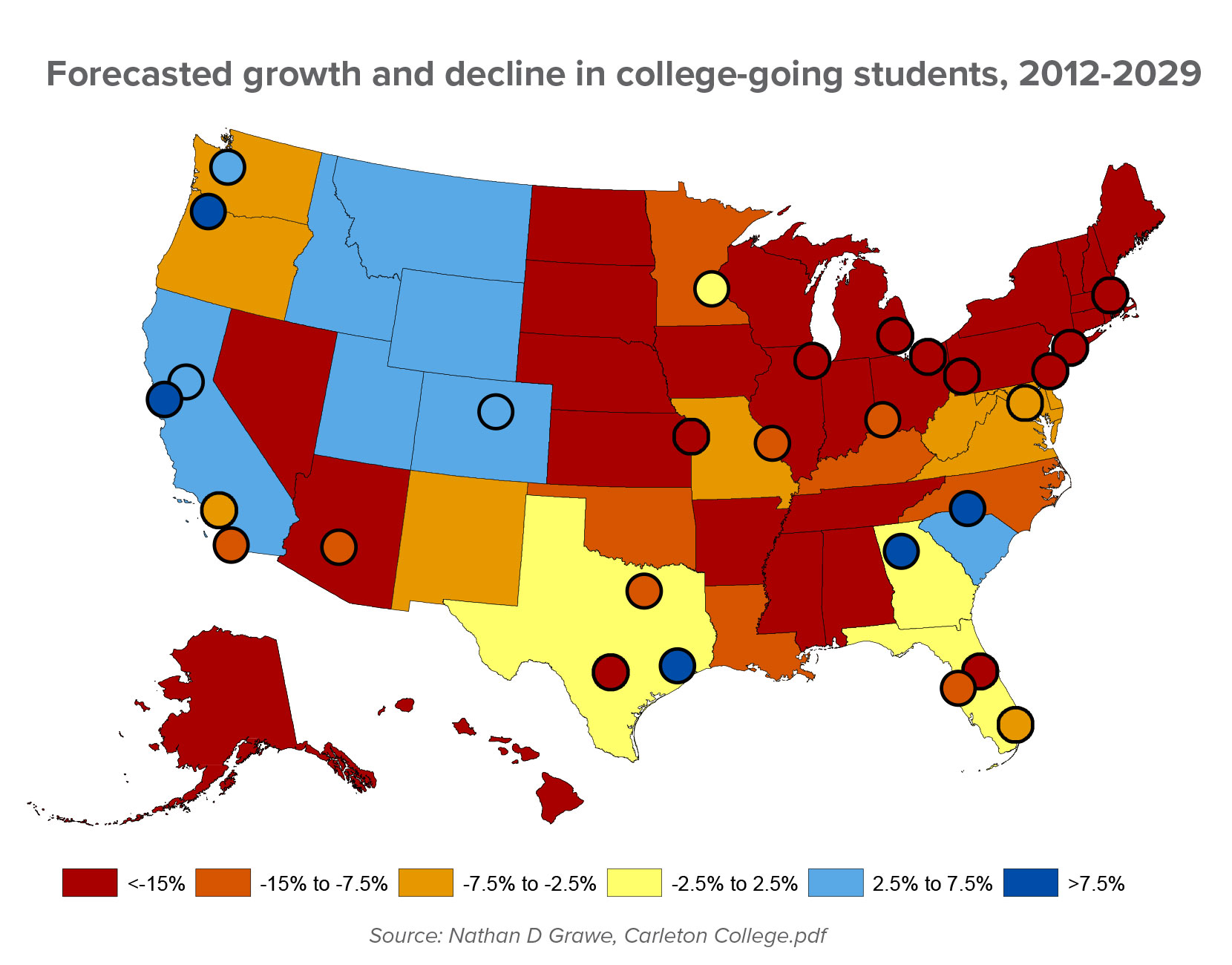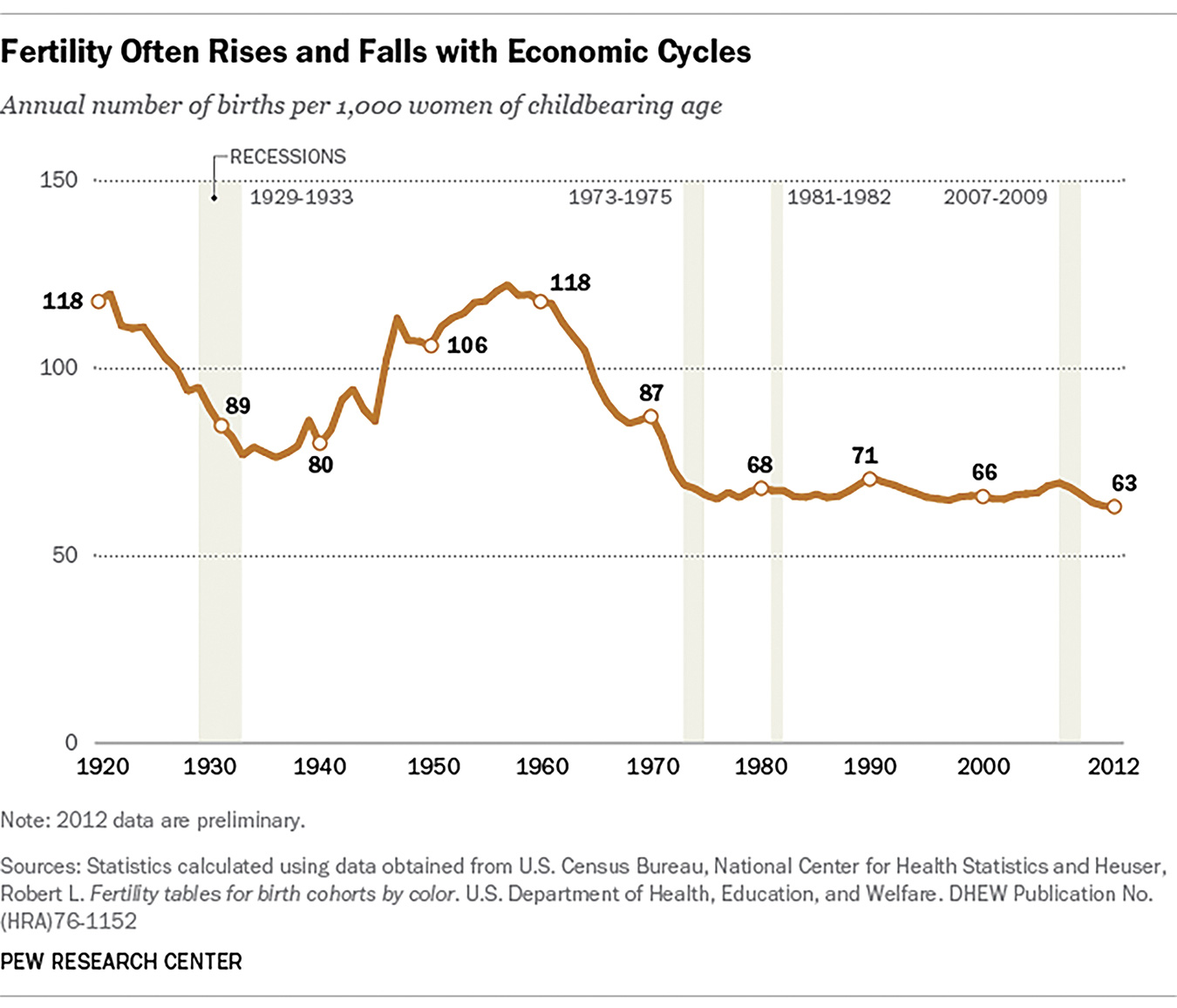The Looming Higher Ed Enrollment Cliff
“U.S. Birthrate Drops 4th Year in a Row, Possibly Echoing the Great Recession”
“U.S. Births Fell to a 32-Year Low in 2018; CDC Says Birthrate Is in Record Slump”
“The U.S. Birthrate Is Still Falling”
“College Students Predicted to Fall by More Than 15 Percent After the Year 2025”
These are just some of the headlines that have been making the rounds in the media of late. According to the data, when the Great Recession hit in 2008, the birthrate took a nosedive that many attributed to the economy. However, while the economy has rebounded in the decade since, the birthrate has not.
The implications of a declining U.S. birthrate are widespread, not the least of which is how the nation’s colleges and universities will be impacted by a rapid drop in college-aged individuals in the general population. This looming enrollment cliff is being talked about among presidents’ cabinets and boards of trustees across the nation, as higher ed leaders look to get in front of this challenge.
What conversations are happening, and what actions are higher ed institutions taking to prepare for a possible decline in tuition dollars in the coming years? What can HR leaders do to prepare for the cascading effects of fewer students on campus?

The Stats
While not all colleges and universities will see a decline in student enrollment, many of those that do will be hit hard. In a recent article in The Hechinger Report, columnist Jill Barshay writes that elite institutions will likely fare much better than regional four-year colleges and universities, which are expected to be impacted the most. According to the article, which cites research by economist and Carleton College professor Nathan Grawe, regional bachelor’s institutions are expected to lose more than 11 percent of their students by 2029, while demand for elite institutions may be up to 14 percent higher in 2029 than it was in 2012.
Why the contrast? As Grawe explains to Barshay in the article, “elite colleges are less affected by the birth dearth because they’re a small, niche market of fewer than 200,000 students.” He also cites the boom in the Asian-American population, which, he says, has a “high attachment to higher education, and elite higher education in particular.”
In addition to institution type, location will have some bearing on the impact of the declining college-age population. Citing Grawe’s research, Barshay writes in the article, “the Northeast, where a disproportionate share of the nation’s colleges and universities are located, is expected to be the hardest hit. By contrast, mountain states, where there are fewer students and fewer colleges … may see slight increases in student demand,” as could institutions in the Southwest due to high rates of immigration over the past several years — although immigration has slowed considerably as of late.
The bottom line is that many of the nation’s colleges and universities will face declining or stagnant student enrollment rates beginning in about six years, a reality which will require a thoughtful, strategic approach to ensure the viability and sustainability of those institutions. And while human resources leaders may not always be invited to participate in high-level conversations among executive leadership, HR must ensure that it’s proactively contributing to the conversation and taking steps now to be ready to act when change comes calling.
A Sweeping Reorganization in Progress
University of Tulsa (TU) is taking action now to cement its place in the future of higher education by reimagining its purpose and reorganizing its structure. Among the changes: the phasing out of 84 low-demand degree programs; the grouping of the business, health and law colleges into one “professional college;” the creation of a university studies program in which all incoming freshman will start their academic journey; and a shift away from academic departments to interdisciplinary divisions. And it’s happening quickly — over the next two years (although the university has committed to teaching out students currently enrolled in the affected degree programs).
TU’s new model includes a STEM-heavy curriculum, a high-touch education providing both practical and professional training, and a focus on undergraduate studies. Explains TU Provost Janet Levit in communications to the TU community, “These changes are about reprioritizing and reallocating our resources to support those programs with the greatest demand, which will have the greatest opportunity for success as we navigate into uncharted higher ed terrain.”
Change of this magnitude touches every campus constituent — students, staff, faculty, the surrounding community — and requires thoughtful consideration, innovative thinking and strategic collaboration to carry out.
Many higher ed institutions will face declining or stagnant student enrollment beginning in about six years, a reality which will require a thoughtful, strategic approach to ensure the viability and sustainability of those institutions.
How will the reimagining of TU impact the university’s workforce? University leadership has pledged to undertake this change without an immediate reduction in force and without eliminating tenured or tenure-track faculty appointments, instead offering an early retirement option for qualified faculty. In addition, all TU employees will receive a 2 percent pay increase.
The magnitude of change at TU will no doubt present its share of challenges, but it will also offer a multitude of learning opportunities for the university’s human resources organization.
Spreading Awareness and Anticipating Challenges
Indiana University (IU), which includes the Bloomington campus, IUPUI and seven other regional campuses, is another institution facing the likelihood of a decline in student enrollment in the coming years, as the number of high school graduates in the Midwest is projected to drop off significantly beginning in 2025. IU sees this enrollment cliff as a looming challenge.
John Whelan, the university’s chief HR officer, has made it a priority to create awareness and share with other university leaders HR’s perspective on how fewer students will impact IU’s workforce. “There are certain people in the university who understand the implications of the enrollment decline based on their jobs, but the broader IU staff and faculty generally don’t know much about this,” says Whelan. “My priority has been to bring up this topic in every HR meeting and forum at IU over the past year, and I’ll continue to do so.”
Additionally, Whelan says he has been encouraging his HR staff to engage the financial and enrollment leaders within their campuses, divisions and units to understand the impact of fewer students on their specific areas. “Some of our programs are already feeling the pressure, while others probably won’t feel the pain for several years, if at all,” he says. “Through these collaborative, campus-wide conversations, our HR professionals are getting a clearer understanding of how HR can be part of the solution.”
Whelan suggests that HR leaders at institutions looking down the pike at an enrollment decline should be having regular conversations now with their senior leaders to understand the details and nuances around the issue. While the overall problem is easily explained, he says, each organizational unit will have different challenges that will require unique solutions — and understanding the financial and enrollment data will make this a more tangible project to focus on.
Because most higher education institutions rely on tuition dollars as their largest revenue source, a decline in enrollment has the potential to keep revenue flat or to even reduce it. On the flip side, salary and benefits costs make up the vast majority of expenses in most universities, and these need to grow each year in order to keep salaries competitive and to adjust for the increased costs in healthcare.
“If revenue stays flat or declines,” Whelan says, “there will be a significant impact on institutions’ abilities to maintain their workforces. Those colleges and universities that will be hardest hit by this enrollment cliff need to start planning now in order to reduce the likelihood of reductions in force in the future, or at least to ensure if layoffs are unavoidable, they’re done in an equitable and nondiscriminatory way.”
Whelan also points to the need for HR to focus its efforts on employee morale and engagement. “Staff and faculty who will be asked to do more with less can easily become discouraged and frustrated, and with a strong economy and low unemployment rates, these workers will have many options to find other employment,” he says.
Whelan says in order to help ready their institutions for the challenges the next several years stand to bring, HR leaders need to be involved in discussions and planning around finances, data mining and data-driven decisions, change management and communication strategies. “In bringing our expertise to the table, we as HR leaders have an opportunity to be proactive instead of reactive — to show our value as a strategic partner and a contributor to our institutions’ missions, values and goals.”
Best HR Practices
At a recent meeting of the CUPA-HR board of directors, the enrollment cliff was the main topic of discussion. These higher ed HR leaders from different institution types across the country served as a think tank of sorts, sharing their thoughts on what the higher ed landscape might look like in five to eight years, sharing their institutions’ current and coming realities around enrollment and retention, and discussing what HR can and should be doing to help higher ed leaders and their institutions prepare for whatever the future may bring.
Some of the suggestions that came out of that discussion:
Engage with campus leaders now, as this will up the odds that HR is called upon as a partner when decisions are being made. Susan Norton, vice president for human resources at Augusta University in Georgia, shares that when she reached out to her recently hired vice president of enrollment and student affairs in preparation for the board discussion, the VP replied that she had never been asked about enrollment by an HR colleague and was excited about the opportunity to partner with HR. Says Norton, “This is an example of how we have an opportunity to engage with campus leaders; everyone is a recruiter. Every encounter we have with someone is an opportunity to be an ambassador for our institution.”
HR leaders at institutions looking down the pike at an enrollment decline should be having regular conversations now with their senior leaders to understand the details and nuances around the issue.
Bring data to the table. HRIS at Clemson University has partnered with the budget office to create a data analytics dashboard. “Being able to provide data for deans, divisional leaders and vice presidents to help them make decisions is a value add for our customers,” says Dr. Ale Kennedy, associate chief HR officer at Clemson. “There are a lot of decisions the university is making, and they want and need data to make those decisions. Because HR was proactive in bringing that data to the table, our university leaders are now relying more and more on us to provide those stats and numbers.”
Marie Williams, associate vice chancellor for HR at North Carolina State University, adds that HR’s mission shouldn’t be to be at the table at all times, but instead “we should focus on bringing value and influence by being prepared to share with institutional leadership the data they need to make decisions.”
Collaborate. Kennedy shared that at Clemson, HR strategic consultants (a new position) are working on workforce planning and human capital strategic initiatives across the university. Says Kennedy, “HR strategic consultants collaborate and work closely with all the HR services teams and centers of excellence across campus to put HR ahead of the necessary changes, so we can position our organization to be proactive.”
Understand the business of higher education. Says Jay Stephens, vice president for human capital services at Kansas State University, “As HR leaders we have to understand enrollment, the tie to budgets and the strategic initiatives our campuses are undertaking to address those things. Without that demonstrated knowledge to our colleagues, namely our provosts and chief financial officers, we won’t be pulled into the discussion and decision-making; instead they will bring us in on the back end, when the decisions have already been made. We have to be credible partners in understanding the business of higher education.”
Hone your consultative skills, communication and business acumen — all important skills for HR professionals to have in order to contribute in a meaningful way to discussions and planning around how the institution will navigate challenges related to student enrollment and retention. However, says John Martin, director of client services at Princeton University, “This seat at the table is something that must be earned — it’s not necessarily guaranteed.”
Build resilient HR teams. It is important to build resilient HR teams that can represent the mission and purpose of the various offices of the university. “HR teams should be empowered to say ‘yes’ and only get the chief HR officer involved when a ‘no’ is necessary, as this this will help in building collaborative relationships across the university,” says Pierre Joanis, vice president for HR at Bucknell University.
Taking the Long View
Whether your institution expects the impact of the steep decline in high school graduates to be minimal or extensive, now is the time to spread awareness and position HR as an invaluable resource to other campus leaders.
About the author: Missy Kline is content manager for communications and marketing at CUPA-HR and managing editor of Higher Ed HR Magazine.


